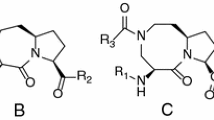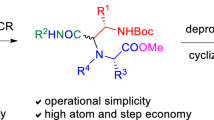Abstract
An approach to rel-(4aS,6R,7aR)-octahydro-1H-cyclopenta[b]pyridine-6-carboxylic acid—a bicyclic conformationally restricted γ-aminobutyric acid (GABA) analogue was developed. The eight-step sequence relied on the reaction of 2,3-bis(chloromethyl)pyridine and a C1-binucleophile and the catalytic reduction of the pyridine ring as the key steps and allowed for the preparation of the title compound in 9.0% overall yield. Assessment of the octahydro-1H-cyclopenta[b]pyridine scaffold geometry showed that this template can be considered truly three-dimensional.





Similar content being viewed by others
References
Aceña JL, Sorochinsky AE, Soloshonok V (2014) Asymmetric synthesis of α-amino acids via homologation of Ni(II) complexes of glycine Schiff bases. Part 3: Michael addition reactions and miscellaneous transformations. Amino Acids 46:2047–2073. https://doi.org/10.1007/s00726-014-1764-5
Bordwell FG (1988) Equilibrium acidities in dimethyl sulfoxide solution. Acc Chem Res 21:456–463. https://doi.org/10.1021/ar00156a004
Cativiela C, Ordóñez M (2009) Recent progress on the stereoselective synthesis of cyclic quaternary alpha-amino acids. Tetrahedron Asymmetry 20:1–63. https://doi.org/10.1016/j.tetasy.2009.01.002
Chebib M, Allan RD, Duke RK, Johnston GAR (2001) The effects of cyclopentane and cyclopentene analogues of GABA at recombinant GABAC receptors. Eur J Pharmacol 430:185–192. https://doi.org/10.1016/S0014-2999(01)01390-5
Crittenden DL, Jordan MJT, Chebib M, Crittenden DL, Park A, Qiu J, Silverman RB, Duke RK, Johnston GAR (2006) Enantiomers of cis-constrained and flexible 2-substituted GABA analogues exert opposite effects at recombinant GABA(C) receptors. Bioorg Med Chem 14:447–455. https://doi.org/10.1016/j.bmc.2005.08.037
Fang Z, Song Y, Zhan P, Zhang Q, Liu X (2014) Conformational restriction: an effective tactic in ‘follow-on’-based drug discovery. Future Med Chem 6:885–901. https://doi.org/10.4155/fmc.14.50
Fülöp F, Martinek TA, Tóth GK (2006) Application of alicyclic β-amino acids in peptide chemistry. Chem Soc Rev 2006:323–334. https://doi.org/10.1007/10.1039/B501173F
Gellman SH (1998) Foldamers: a manifesto. Acc Chem Res 31:173–180. https://doi.org/10.1021/ar960298r
Grimm JS, Maryanoff CA, Patel M, Palmer DC, Sorgi KL, Stefanick S, Webster RRH, Zhang X (2002) Reaction safety: a critical parameter in the development of a scalable synthesis of 2,3-bis-chloromethylpyridine hydrochloride. Org Proc Res Dev 6:938–942. https://doi.org/10.1021/op025545n
Grygorenko OO, Babenko P, Volochnyuk DM, Raievskyi O, Komarov IV (2016) Following Ramachandran: exit vector plots (EVP) as a tool to navigate chemical space covered by 3D bifunctional scaffolds. The case of cycloalkanes. RSC Adv 6:17595–17605. https://doi.org/10.1039/C5RA19958A
Grygorenko OO, Demenko D, Volochnyuk DM, Komarov IV (2018) Following Ramachandran 2: exit vector plot (EVP) analysis of disubstituted saturated rings. New J Chem 42:8355–8365. https://doi.org/10.1039/c7nj05015a
Guthikonda RN, Shah SK, Pacholok SG, Humes JL, Mumford RA, Grant SK, Chabin RM, Green BG, Tsou N, Ball R, Fletcher DS, Luell S, Euan MacIntyre D, Maccoss M (2005) Bicyclic amidine inhibitors of nitric oxide synthase: discovery of perhydro-iminopyrindine and perhydro-iminoquinoline as potent, orally active inhibitors of inducible nitric oxide synthase. Bioorg Med Chem Lett 15:1997–2001. https://doi.org/10.1016/j.bmcl.2005.02.067
Janecka A, Kruszynski R (2005) Conformationally restricted peptides as tools in opioid receptor studies. Curr Med Chem 12:471–481. https://doi.org/10.2174/0929867053362983
Kaneda M, Nakamura S, Iitaka Y (1980) Absolute structure of amidinomycin. J Antibiot 33:778–780. https://doi.org/10.7164/antibiotics.33.778
Kiss L, Cherepanova M, Fülöp F (2015) Recent advances in the stereoselective syntheses of acyclic disubstituted β2,3-amino acids. Tetrahedron 71:2049–2069. https://doi.org/10.1016/j.tet.2015.01.060
Kobayashi T, Suemasa A, Igawa A, Ide S, Fukuda H, Abe H, Arisawa M, Minami M, Shuto S (2014) Conformationally restricted gaba with bicyclo[3.1.0]hexane backbone as the first highly selective BGT-1 inhibitor. ACS Med Chem Lett 5:889–893. https://doi.org/10.1021/ml500134k
Komarov IV, Grigorenko AO, Turov AV, Khilya VP (2004) Conformationally rigid cyclic α-amino acids in the design of peptidomimetics peptide models and biologically active compounds. Russ Chem Rev 73:785–810. https://doi.org/10.1070/RC2004v073n08ABEH000912
Mann A (2008) Conformational restriction and/or steric hindrance in medicinal chemistry. In: Wermuth CG (ed) Practice of medicinal chemistry, 3rd edn. Academic Press/Elsevier, Amsterdam, pp 363–379. ISBN 0123741947
Mora AJ, Avila EE, Delgado GE, Fitch AN, Brunelli M (2005) Temperature effects on the hydrogen-bond patterns in 4-piperidine-carboxylic acid. Acta Cryst Sect B 61:96–102. https://doi.org/10.1107/S0108768104031738
Mortensen M, Kristiansen U, Ebert B, Frølund B, Krogsgaard-Larsen P, Smart TG (2004) Activation of single heteromeric GABAA receptor ion channels by full and partial agonists. J Physiol 557:389–413. https://doi.org/10.1113/jphysiol.2003.054734
Ordóñez M, Cativiela C (2007) Stereoselective synthesis of γ-amino acids. Tetrahedron Asymmetry 18:3–99. https://doi.org/10.1016/j.tetasy.2006.12.001
Pingsterhaus JM, Qiu J, Silverman RB (1999) Inhibition and substrate activity of conformationally rigid vigabatrin analogues with γ-aminobutyric acid aminotransferase. J Med Chem 42:4725–4728. https://doi.org/10.1021/jm990271o
Soloshonok VA (2002) Highly diastereoselective Michael addition reactions between nucleophilic glycine equivalents and β-substituted-α, β-unsaturated carboxylic acid derivatives a general approach to the stereochemically defined and sterically χ-constrained α-amino acids. Curr Org Chem 6:341–364. https://doi.org/10.2174/1385272024605014
Sorochinsky A, Aceña J, Moriwaki H, Sato T, Soloshonok V (2013a) Asymmetric synthesis of α-amino acids via homologation of Ni(II) complexes of glycine Schiff bases; part 1: alkyl halide alkylations. Amino Acids 45:691–718. https://doi.org/10.1007/s00726-013-1539-4
Sorochinsky A, Aceña J, Moriwaki H, Sato T, Soloshonok V (2013b) Asymmetric synthesis of α-amino acids via homologation of Ni(II) complexes of glycine Schiff bases. Part 2: Aldol, Mannich addition reactions, deracemization and (S) to (R) interconversion of α-amino acids. Amino Acids 45:1017–1033. https://doi.org/10.1007/s00726-013-1580-3
Szabo CM, Martin MB, Oldfield E (2002) An investigation of bone resorption and Dictyostelium discoideum growth inhibition by bisphosphonate drugs. J Med Chem 45:2894–2903. https://doi.org/10.1021/jm010279+
Trabocchi A, Scarpi D, Guarna A (2008) Structural diversity of bicyclic amino acids. Amino Acids 34:1–24. https://doi.org/10.1007/s00726-007-0588-y
Vagner J, Qu H, Hruby V (2008) Peptidomimetics, a synthetic tool of drug discovery. Curr Opin Chem Biol 12:292–296. https://doi.org/10.1016/j.cbpa.2008.03.009
Van Bever WFM, Knaeps AG, Willems JJM, Hermans BKF, Janssen PAJ (1973) Synthetic analgesics. Synthesis and pharmacology of the diastereoisomers of N-[3-methyl-1-(2-phenylethyl)-4-piperidyl]-N-phenylpropanamide and N-[3-methyl-1-(1-methyl-2-phenylethyl)-4-piperidyl]-N-phenylpropanamide. J Med Chem 16:394–397. https://doi.org/10.1021/jm00256a003
Wang Y, Song X, Wang J, Moriwaki H, Soloshonok V, Liu H (2017) Recent approaches for asymmetric synthesis of α-amino acids via homologation of Ni(II) complexes. Amino Acids 49:1487–1520. https://doi.org/10.1007/s00726-017-2458-6
Witiak DT, Patch RJ, Enna SJ, Fung YK (1986) Stereoselective syntheses of the trans-decahydroquinoline-5-carboxylic acid epimers. Diastereomeric zwitterionic probes of γ-aminobutyric acid-related biological properties in vitro and in vivo. J Med Chem 29:1–8. https://doi.org/10.1021/jm00151a001
Woll MG, Lai JR, Guzei IA, Taylor SJC, Smith MEB, Gellman SH (2001) Parallel sheet secondary structure in γ-peptides. J Am Chem Soc 123:11077–11078. https://doi.org/10.1021/ja011719p
Acknowledgements
The authors thank Prof. Andrey A. Tolmachev for his encouragement and support and Ms. Yuliya Kuchkovska for her help with preparation of Fig. 3.
Author information
Authors and Affiliations
Corresponding author
Ethics declarations
Conflict of interest
The authors declare no conflict of interests.
Funding
The work was funded by Enamine Ltd.
Ethical approval
This article does not contain any studies with human participants or animals performed by any of the authors.
Additional information
Handling Editor: V. Soloshonok.
Rights and permissions
About this article
Cite this article
Melnykov, K.P., Volochnyuk, D.M., Ryabukhin, S.V. et al. A conformationally restricted GABA analogue based on octahydro-1H-cyclopenta[b]pyridine scaffold. Amino Acids 51, 255–261 (2019). https://doi.org/10.1007/s00726-018-2660-1
Received:
Accepted:
Published:
Issue Date:
DOI: https://doi.org/10.1007/s00726-018-2660-1




